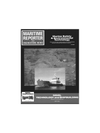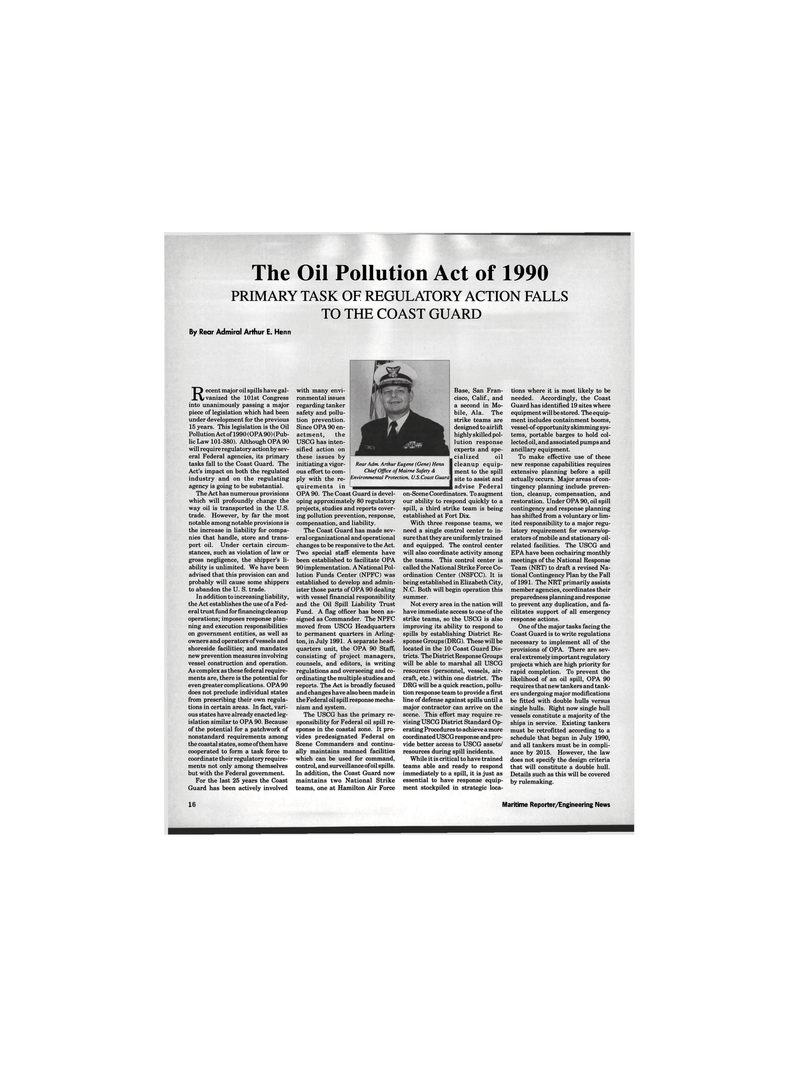
Page 3rd Cover: of Maritime Reporter Magazine (September 1991)
Read this page in Pdf, Flash or Html5 edition of September 1991 Maritime Reporter Magazine
The Oil Pollution Act of 1990
PRIMARY TASK OF REGULATORY ACTION FALLS
TO THE COAST GUARD
By Rear Admiral Arthur E. Henn
Recent major oil spills have gal-vanized the 101st Congress into unanimously passing a major piece of legislation which had been under development for the previous 15 years. This legislation is the Oil
Pollution Act of 1990 (OPA 90) (Pub- lic Law 101-380). Although OPA 90 will require regulatory action by sev- eral Federal agencies, its primary tasks fall to the Coast Guard. The
Act's impact on both the regulated industry and on the regulating agency is going to be substantial.
The Act has numerous provisions which will profoundly change the way oil is transported in the U.S. trade. However, by far the most notable among notable provisions is the increase in liability for compa- nies that handle, store and trans- port oil. Under certain circum- stances, such as violation of law or gross negligence, the shipper's li- ability is unlimited. We have been advised that this provision can and probably will cause some shippers to abandon the U. S. trade.
In addition to increasing liability, the Act establishes the use of a Fed- eral trust fund for financing cleanup operations; imposes response plan- ning and execution responsibilities on government entities, as well as owners and operators of vessels and shoreside facilities; and mandates new prevention measures involving vessel construction and operation.
As complex as these federal require- ments are, there is the potential for even greater complications. OPA90 does not preclude individual states from prescribing their own regula- tions in certain areas. In fact, vari- ous states have already enacted leg- islation similar to OPA 90. Because of the potential for a patchwork of nonstandard requirements among the coastal states, some of them have cooperated to form a task force to coordinate their regulatory require- ments not only among themselves but with the Federal government.
For the last 25 years the Coast
Guard has been actively involved with many envi- ronmental issues regarding tanker safety and pollu- tion prevention.
Since OPA 90 en- actment, the
USCG has inten- sified action on these issues by initiating a vigor- ous effort to com- ply with the re- quirements in
OPA 90. The Coast Guard is devel- oping approximately 80 regulatory projects, studies and reports cover- ing pollution prevention, response, compensation, and liability.
The Coast Guard has made sev- eral organizational and operational changes to be responsive to the Act.
Two special staff elements have been established to facilitate OPA 90 implementation. A National Pol- lution Funds Center (NPFC) was established to develop and admin- ister those parts of OPA 90 dealing with vessel financial responsibility and the Oil Spill Liability Trust
Fund. A flag officer has been as- signed as Commander. The NPFC moved from USCG Headquarters to permanent quarters in Arling- ton, in July 1991. A separate head- quarters unit, the OPA 90 Staff, consisting of project managers, counsels, and editors, is writing regulations and overseeing and co- ordinating the multiple studies and reports. The Act is broadly focused and changes have also been made in the Federal oil spill response mecha- nism and system.
The USCG has the primary re- sponsibility for Federal oil spill re- sponse in the coastal zone. It pro- vides predesignated Federal on
Scene Commanders and continu- ally maintains manned facilities which can be used for command, control, and surveillance of oil spills.
In addition, the Coast Guard now maintains two National Strike teams, one at Hamilton Air Force
Rear Adm. Arthur Eugene (Gene) Henn
Chief Office of Mairne Safety &
Environmental Protection, U.S.Coast Guard
Base, San Fran- cisco, Calif., and a second in Mo- bile, Ala. The strike teams are designed to airlift highly skilled pol- lution response experts and spe- cialized oil cleanup equip- ment to the spill site to assist and advise Federal on-Scene Coordinators. To augment our ability to respond quickly to a spill, a third strike team is being established at Fort Dix.
With three response teams, we need a single control center to in- sure that they are uniformly trained and equipped. The control center will also coordinate activity among the teams. This control center is called the National Strike Force Co- ordination Center (NSFCC). It is being established in Elizabeth City,
N.C. Both will begin operation this summer.
Not every area in the nation will have immediate access to one of the strike teams, so the USCG is also improving its ability to respond to spills by establishing District Re- sponse Groups (DRG). These will be located in the 10 Coast Guard Dis- tricts. The District Response Groups will be able to marshal all USCG resources (personnel, vessels, air- craft, etc.) within one district. The
DRG will be a quick reaction, pollu- tion response team to provide a first line of defense against spills until a major contractor can arrive on the scene. This effort may require re- vising USCG District Standard Op- erating Procedures to achieve a more coordinated USCG response and pro- vide better access to USCG assets/ resources during spill incidents.
While it is critical to have trained teams able and ready to respond immediately to a spill, it is just as essential to have response equip- ment stockpiled in strategic loca- tions where it is most likely to be needed. Accordingly, the Coast
Guard has identified 19 sites where equipment will be stored. The equip- ment includes containment booms, vessel-of-opportunity skimming sys- tems, portable barges to hold col- lected oil, and associated pumps and ancillary equipment.
To make effective use of these new response capabilities requires extensive planning before a spill actually occurs. Major areas of con- tingency planning include preven- tion, cleanup, compensation, and restoration. Under OPA 90, oil spill contingency and response planning has shifted from a voluntary or lim- ited responsibility to a major regu- latory requirement for owners/op- erators of mobile and stationary oil- related facilities. The USCG and
EPA have been cochairing monthly meetings of the National Response
Team (NRT) to draft a revised Na- tional Contingency Plan by the Fall of 1991. The NRT primarily assists member agencies, coordinates their preparedness planning and response to prevent any duplication, and fa- cilitates support of all emergency response actions.
One of the major tasks facing the
Coast Guard is to write regulations necessary to implement all of the provisions of OPA. There are sev- eral extremely important regulatory projects which are high priority for rapid completion. To prevent the likelihood of an oil spill, OPA 90 requires that new tankers and tank- ers undergoing major modifications be fitted with double hulls versus single hulls. Right now single hull vessels constitute a majority of the ships in service. Existing tankers must be retrofitted according to a schedule that began in July 1990, and all tankers must be in compli- ance by 2015. However, the law does not specify the design criteria that will constitute a double hull.
Details such as this will be covered by rulemaking. 14 Maritime Reporter/Engineering News

 14
14

 4th Cover
4th Cover
